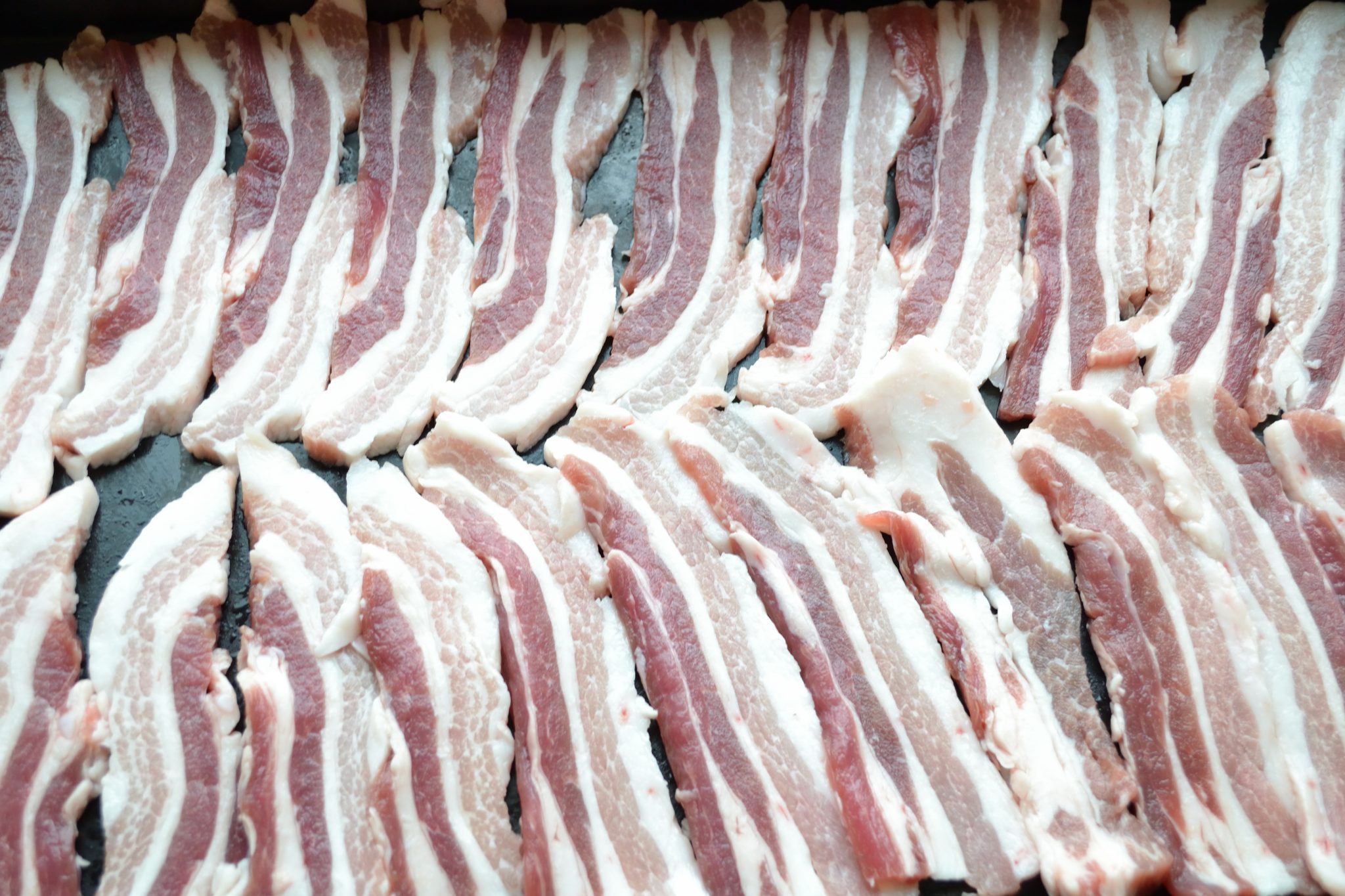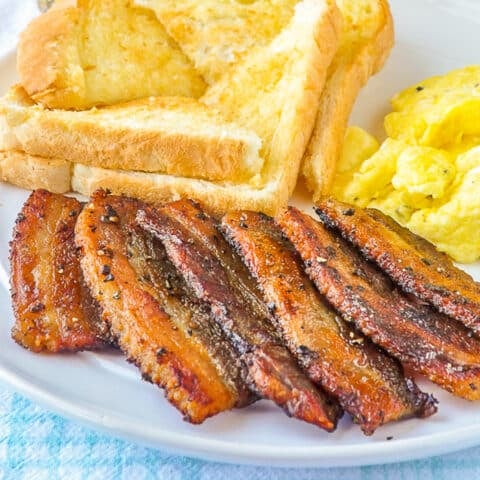Uncured bacon offers a delicious alternative to regular cured bacon, without nitrites or excess sodium. Seasoning and flavoring your own uncured bacon at home opens a world of possibilities.
You control the ingredients, so you can create gourmet bacon seasoned with spices, herbs, sugars, and more. From sweet to savory and everything in between, it’s easy to make uncured bacon bursting with flavor.
This complete guide covers:
- How to make basic uncured bacon
- Seasoning and flavor combinations for uncured bacon
- Step-by-step instructions for seasoning uncured bacon
- Tips for cooking and storing seasoned uncured bacon
Read on to learn how to take your homemade uncured bacon to bold new heights with incredible flavors.
How to Make Uncured Bacon
The first step is knowing the basic process for making uncured bacon at home, Here is an overview
Ingredients
- Pork belly
- Salt
- Sugar or sweetener like maple syrup or honey
- Herbs and spices (optional)
Directions
-
Slice the pork belly into strips about 1⁄4 inch thick,
-
Create a dry cure rub by mixing salt, sugar, and any herbs or spices.
-
Generously coat the pork belly strips on both sides with the cure mixture.
-
Place the coated pork belly in a sealed bag or container. Refrigerate for 5-7 days, flipping occasionally.
-
Rinse and pat dry the cured pork belly strips.
-
Bake at 200-225°F until cooked through, about 2 hours.
-
Cool completely before slicing to serve or storing.
Now let’s look at how to take this basic uncured bacon to the next level with different seasonings.
Seasoning Ideas for Uncured Bacon
One benefit of homemade uncured bacon is that you can flavor it however you like. Consider these seasoning ideas:
Sweet Uncured Bacon
- Maple syrup or honey
- Brown sugar or coconut sugar
- Fruit jam, chutney, or preserves
- Vanilla extract
- Cinnamon and nutmeg
Savory Uncured Bacon
- Smoked paprika or chipotle powder
- Fresh cracked black pepper
- Onion powder and garlic powder
- Ground cumin or ancho chile powder
- Italian seasoning or herbes de Provence
Spicy Uncured Bacon
- Cayenne pepper or crushed red pepper
- Jalapeño or habanero powder
- Ground ginger or mustard powder
- Cracked black pepper and red pepper flakes
- Curry powder or five-spice powder
Herbed Uncured Bacon
- Fresh or dried rosemary, thyme, or sage
- Oregano, marjoram, dill, or basil
- Finely chopped fresh parsley or cilantro
- Savory, tarragon, lavender, or lemon zest
Mix and match to create your own signature flavors. Try rubbed spices, fresh chopped herbs, zests, purees, or hard ingredients like crushed peppercorns. Now let’s get into how to properly season uncured bacon.
Step-By-Step Guide to Seasoning Uncured Bacon
Follow these simple steps for flavorful, gourmet uncured bacon:
1. Prepare pork belly
- Purchase a pork belly slab and remove the skin and bones.
- Slice the pork belly into long strips, about 1⁄4 to 1⁄2 inch thick.
2. Make seasoning blend
- Select your desired herbs, spices, sugars, etc.
- Mix together in a small bowl to form a seasoning rub.
- Crush any larger spices like peppercorns.
3. Generously season the pork belly
- Place the pork belly strips in a baking dish or sealable bag.
- Liberally rub the seasoning all over both sides of each strip. Apply an even coating.
- Flip and repeat on the other side.
4. Cure the seasoned pork belly
- Seal the pork belly in the bag or cover the baking dish with plastic wrap.
- Refrigerate for 5-7 days, flipping the bag or dish once a day.
- The salt will draw out moisture while the flavor permeates the meat.
5. Rinse and dry the pork belly
- After curing, rinse each strip under cool water to remove excess seasoning.
- Pat very dry with paper towels.
6. Slow cook the bacon
- Place the pork belly strips on a baking sheet lined with parchment.
- Bake at 225°F for about 2 hours until cooked through.
- Let cool completely before slicing or storing.
That’s all it takes to make pro-level uncured bacon with incredible homemade flavors.
Tips for Cooking and Storing Seasoned Uncured Bacon
Follow these tips for enjoying your seasoned uncured bacon:
-
Try pan frying over medium-low heat to develop crispy, candied edges.
-
Bake seasoned bacon strips on a rack set over a sheet pan to render fat.
-
Store fully cooked seasoned bacon in an airtight container for 1 week in the fridge.
-
For longer storage, wrap cooked bacon strips individually and freeze for 2-3 months.
-
Thaw frozen seasoned bacon overnight in the fridge before cooking.
-
Add cooked bacon crumbles to salads, soups, potatoes, Brussels sprouts, and more.
With the right techniques, you can make restaurant-worthy uncured bacon at home seasoned with your favorite flavors. Explore sweet and savory blends to create custom uncured bacon.
Frequently Asked Questions About Seasoning Uncured Bacon
Can you season uncured pork belly before curing?
Yes, it is best to season and rub spices directly onto the raw pork belly before the dry curing process. This allows the flavor to permeate the meat completely.
What’s the best way to season for a maple flavor?
For maple-flavored uncured bacon, brush pure maple syrup directly onto the pork belly along with rubbing on extra spices like cinnamon, cloves, allspice, nutmeg, or chili powder.
How long does seasoning need to cure with the pork belly?
Most dry cure seasoning recipes call for curing the seasoned pork belly in the fridge for 5-7 days. Curing for at least that long ensures the pork absorbs the flavors.
Should you rinse pork belly after curing and seasoning?
Yes, it’s important to rinse the cured pork belly to remove any excess seasoning and salt from the exterior before cooking. Pat it very dry after rinsing.
Can you cook seasoned uncured bacon right after curing?
For the best flavor, it’s best to let the cured pork belly rest in the fridge, uncovered, for 24 hours after rinsing off the cure mix. Then you can cook it.
With the right techniques and a little creativity, it’s easy to make incredible seasoned uncured bacon at home.

You control the salt level.
It’s pretty important for the taste of bacon that I add salt, but I decide how much to use.
A lot of people like the taste of salty and sweet together, and I think bacon is one of the best ways to enjoy it. That’s likely why maple bacon is so popular, but again, a lot of bands use fake maple flavors that I really don’t like.
The maple bacon with pepper and smoked salt version is one of my favorites, and I’m going to talk about it today along with some tips on how to change it up. That is my favorite version of this recipe because the sweet, salty, and smokey flavors work so well together.


Beyond this basic recipe.
Be sure to see the notes in this recipe for other suggestions of flavourful additions to this recipe. This recipe also cooks in two steps, but you can serve it right from the oven if you’d rather. The second stage happens only if you reheat it.
After baking in the oven, the bacon can be put in a container that won’t let air in and kept in the fridge. It can then be fried in smaller amounts throughout the week. You can also freeze it in single servings and fry them whenever you want. And wait until you try them on burgers instead of regular bacon!
Now that’s a delicious addition to make your homemade burgers even more special!
For one unique version, try brown sugar with a sprinkle of our Smokin’ Summer Spice Dry Rub!
You may also want to try our very popular recipe for Homemade Breakfast Sausages.
Our Breakfast section has a lot more great recipes just like this one.
It’s easy to keep up with the latest home style cooking & baking ideas from Rock Recipes. Be sure to follow Rock Recipes Facebook Page and follow us on Instagram.
Plus you’ll see daily recipe suggestions from decadent desserts to quick delicious weekday meals too.
You can also sign up for our FREE newsletter to know immediately when we add new recipes. You’ll also get weekly suggestions for great family friendly meals and desserts too! Rock Recipes a participant in the Amazon Services LLC Associates Program, an affiliate advertising program designed to provide a means for us to earn fees by linking to Amazon.com and affiliated sites. Our product recommendations are almost exclusively for those we currently use or have used in the past.


